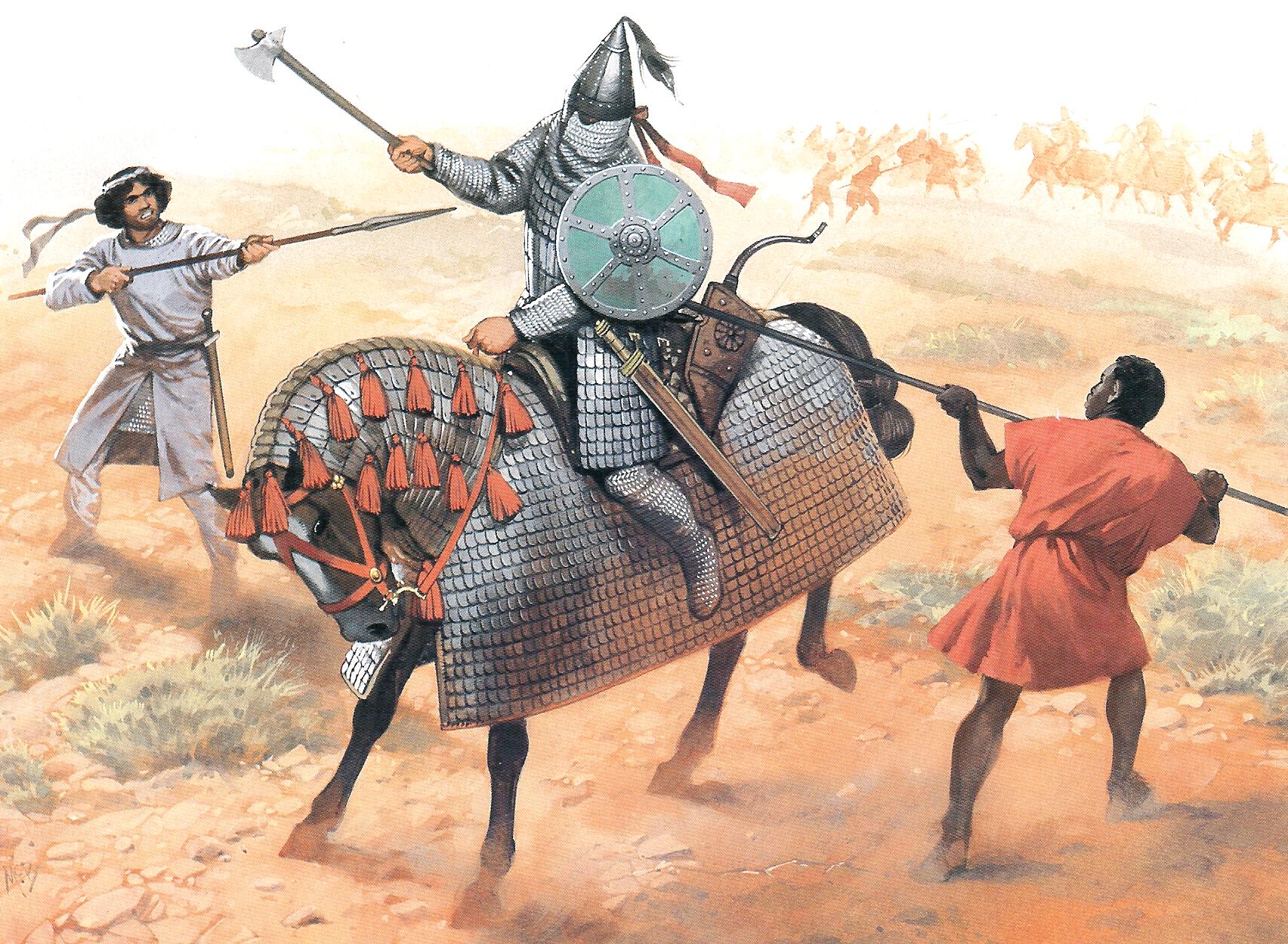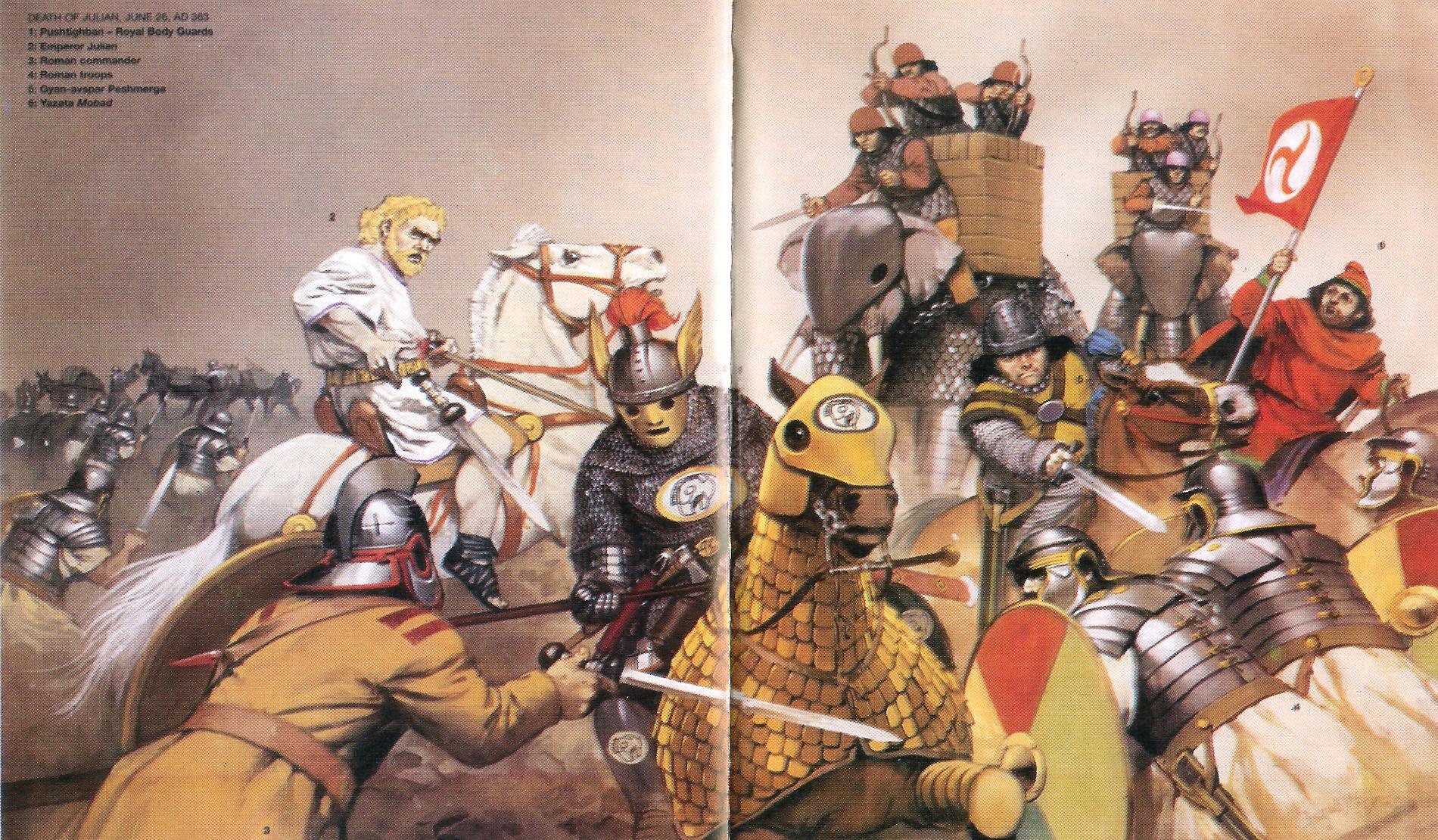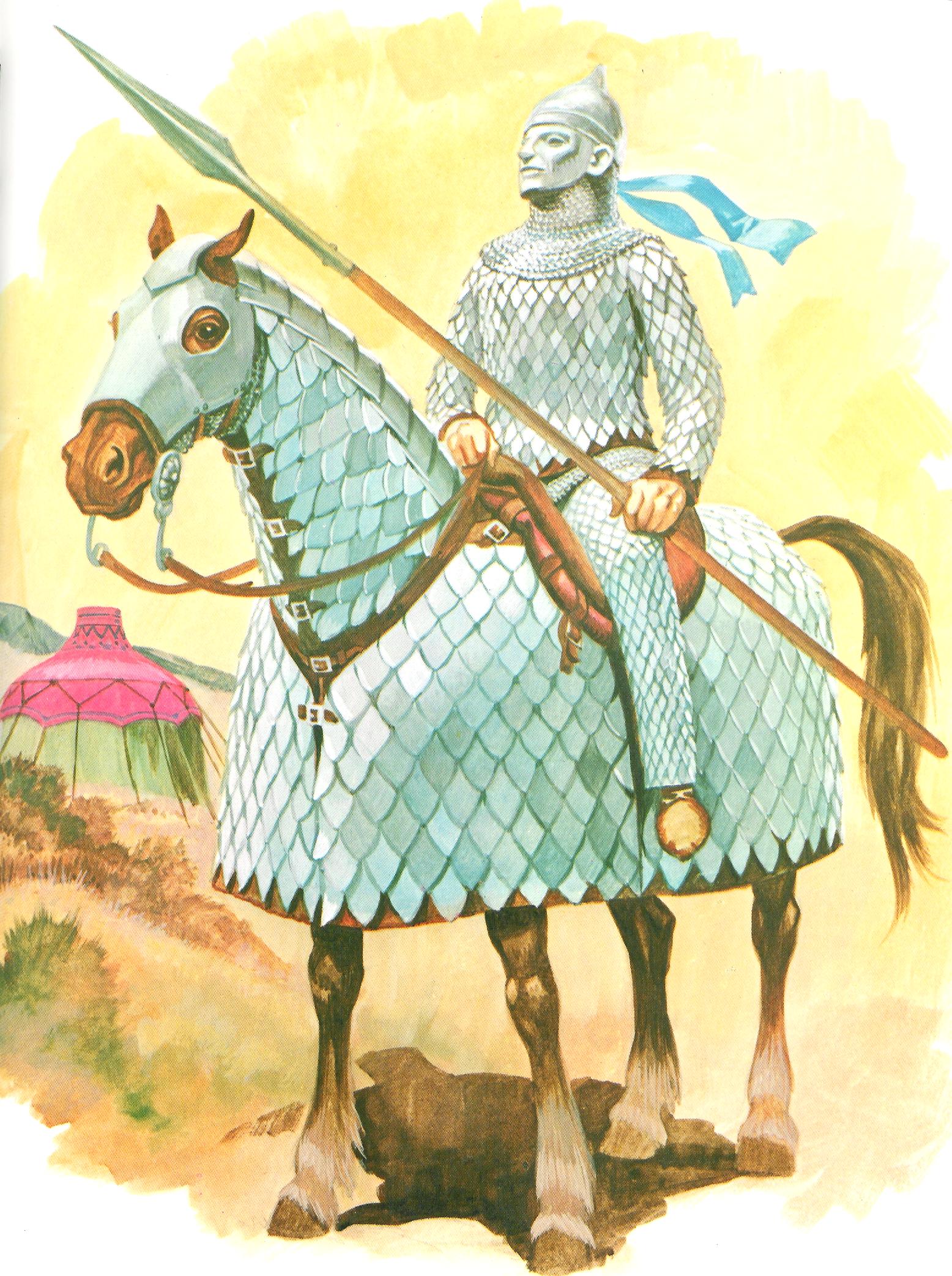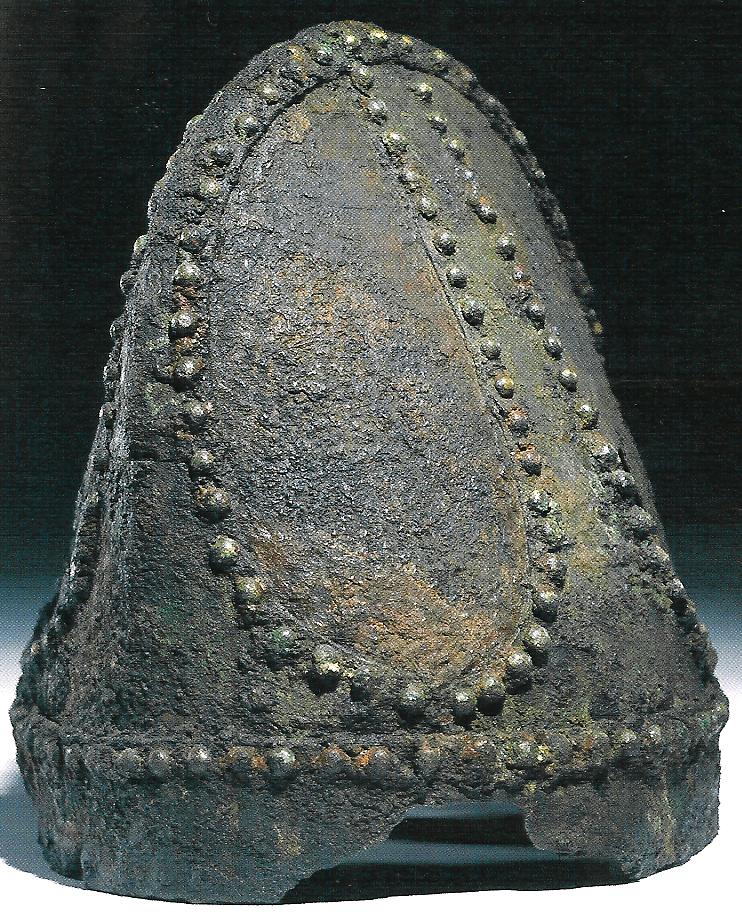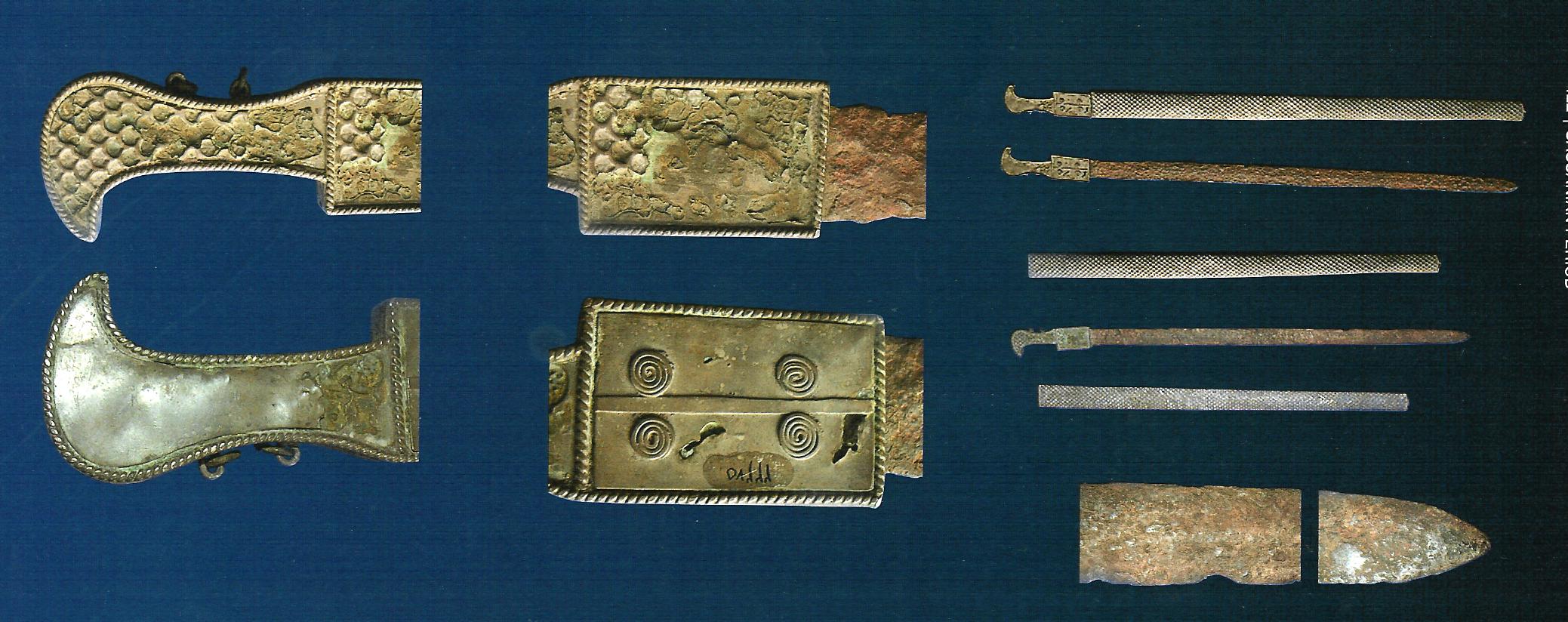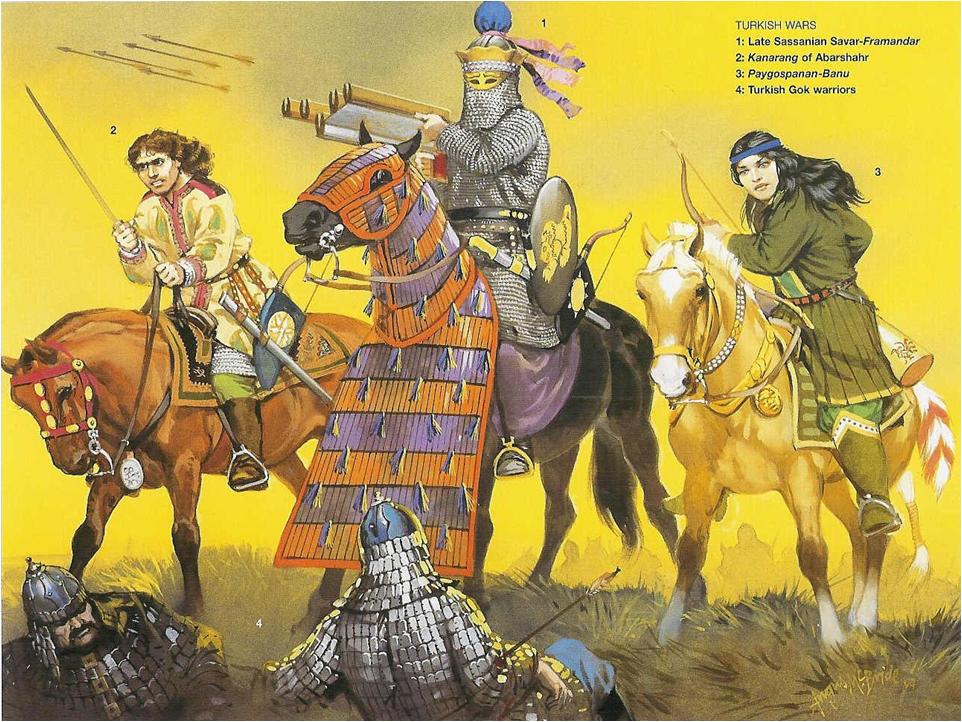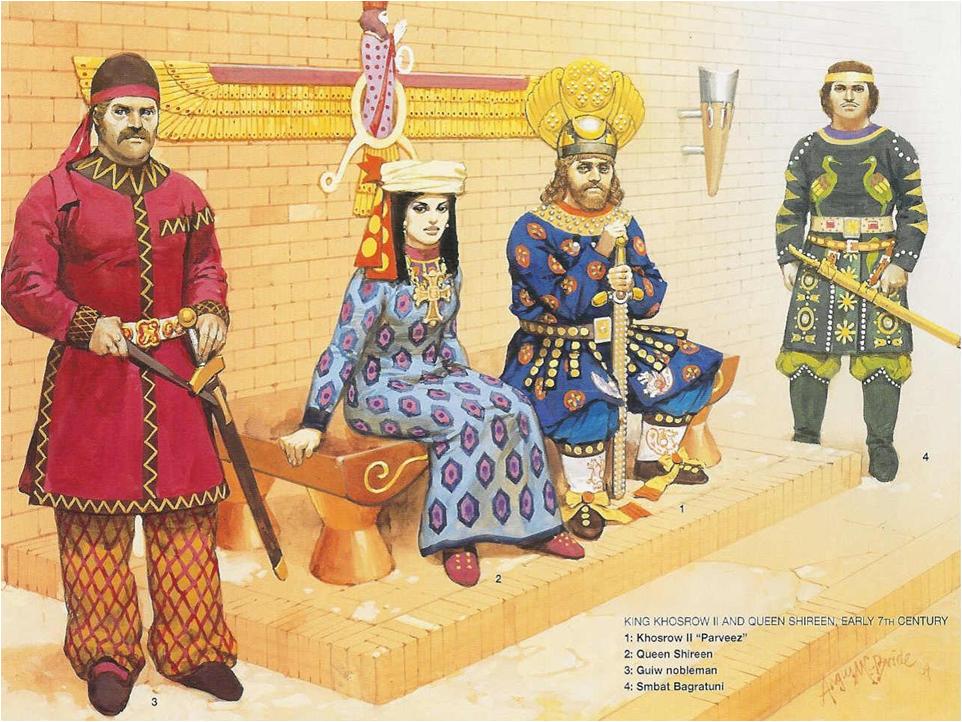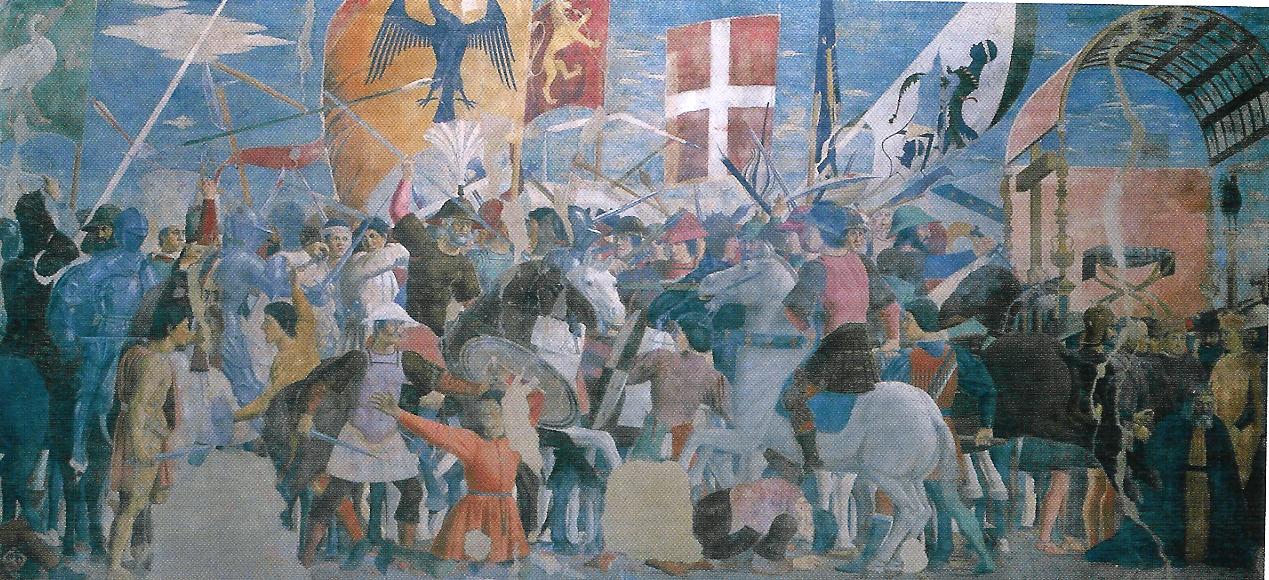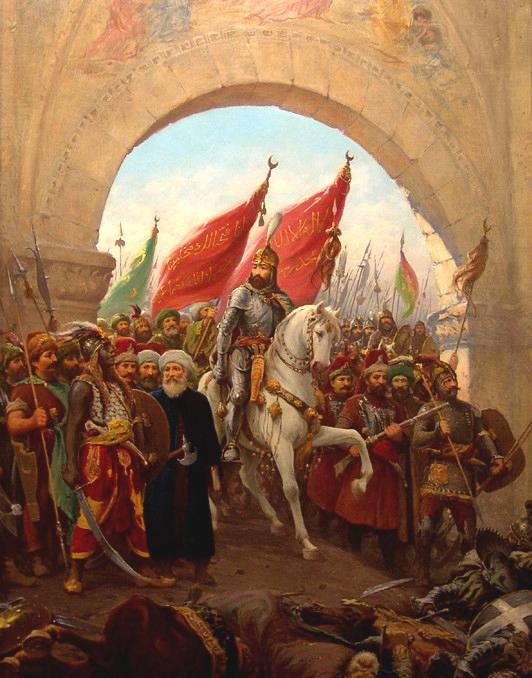The article below is by Nabil Rastani was originally posted on Iranian.com on July 31, 2011. The only difference in the version printed below is that there are pictures and accompanying descriptions not displayed in the original posting on Iranian.com.
=========================================================================
Sassanian Iran and Byzantine Rome were possibly the only two empires on earth to be “hyper-powers” during late antiquity; the Greek speaking Christian Romans (or Byzantines) dominated the countries of Italy, Spain, Greece, Egypt, Syria, Asia Minor (Turkey), Armenia, western Mesopotamia (Iraq) and the Balkans. The Zoroastrian Sassanian Persians ruled an empire that included parts of India, Afghanistan, Pakistan, Iran, eastern Mesopotamia and Tajikistan. These two empires were neighbours and bordered each other from the time of their individual establishment.
The two had been at war for perhaps four hundred years from the early 3rd century to the early 7th century in an epic struggle known as the “Roman Persian wars”. There are a number of reasons for this Great War, the main one being conquest, glory and wealth, the other being more morally based was religion, the Sassanians frequently persecuted and martyred Christians in gruesome ways such as crucifixion, boiling in salt water and even crushing by elephants. (1) This gave the Byzantines a preemptive justification to strike against the Sassanian Empire. While the Sassanians saw a greater picture, being direct descendents of the Achaemenid kings of Persepolis. The Sassanians saw a right to rule over all of what was once under the control of their forefathers. These battles were scattered across the Middle East, most of these conflicts were concentrated in Mesopotamia but also occurred as far reach of the Levant and Asia Minor, and ranged from full scale battles to minor skirmishes and quarrels. Armies and overview of the opposing forces The Byzantines were a shadow of the former Romans of Augustus (2); that said they were broken down into similar types of regiments and organizations. The Byzantine army was as a whole smaller and weaker than that of their predecessors, but by Justinian I (527-565AD) the Byzantine army was reformed into a highly efficient, well trained and armed army. The main regiments in the Byzantine imperial force included the Foederatti (“allies”) units made up of mercenary barbarians and indigenous Roman troops. Comitatenses provided that core force of field troops; these late legionary style heavy infantry were made up of well trained experienced men. Cavalry was also rich and diverse by the early 6th century AD. Unlike the earlier Romans, who had only a select few variety of cavalry available to them, the Byzantines had now created a vast range of cavalry units; from the knight style Kataphraktoi and Clibanarii or Klibanophoroi (developed from the Sassanian cataphracts) to the hippo-toxotai horse archers and lightly armed promoti. Most Byzantine troops were armed with spears, swords, shields and lamellar amour along with high quality steel helmets. Other regiments of Byzantine infantry and cavalry included Limitanei, vexillationes, promoti and the elite Scholae Palatinae. Byzantine technological advances were outstanding for the time and new inventions such as “Greek Fire” a sort of flamethrower as well as many other advances were created as early as the 7th century AD. (3) Byzantines also had an effective navy based in the Mediterranean that could have led fast often deadly strikes at enemy fleets and bases. (4) [CLICK TO ENLARGE] – Byzantine armored cataphract based on Sassanian models as depicted by Ransford. Although the picture is not wholly accurate (later Byzantine cataphracts used combinations of armor, including mail – Ransford’s model uses only scale mail which was typical of the earlier Scythians, Sarmatians and Parthians. Nevertheless, Ransford’s depiction is of interest as it shows the dedication of the Byzantines to create a cavalry force capable of standing up to the Savaran of Iran (Picture source: pp.39, Simon Ransford, War Machines: Land – from the Primitive Weapons of Stone Age man to Rocket-assisted Grenades, London: Octopus Books, 1975). This picture has been displayed as part of Kaveh Farrokh’’s lectures at the University of British Columbia’s Continuing Studies Division and Stanford University’s WAIS 2006 Critical World Problems Conference Presentations on July 30-31, 2006). The backbone of the Sassanian army was unlike the Byzantine army, in the sense that it was more cavalry based rather than infantry based. The heavy Cataphract and Clibanarii provided the elite core force and pièce de résistance of the Sassanian armies, although the Byzantines had their own variation of Cataphracts. They were similar in some respects, albeit the Sassanian Cataphracts were far more experienced and well trained than that of the Byzantines; the Sassanian infantry (at least according to Roman sources) were feeble, and Roman general Belisarius reports that Sassanian infantry: “is nothing more than a crowd of pitiable peasants who come into battle for no other purpose than to dig through walls … and in general to serve the soldiers [cavalry]”. (5) Nevertheless by the reign of Khosrau I (531–579) the Sassanians had begun to deploy elite tough heavy infantry drawn from the provinces of Gilān- the Dailamites. They were a warlike people and skilled in close combat, being armed each with a sword, a shield and spears or javelins. (6) [CLICK TO ENLARGE]- Recreation of Sassanian infantry units during the 2,500 year celebrations of 1971- note the Drafsh Kaviani displayed at the front. Roman descriptions of Sassanian infantry were negative at first, but this changed with the arrival of Dailamite infantry from northern Iran. Picture source: Kaveh Farrokh, pp.230, سایههای صحرا-Shadows in the Desert: Ancient Persia at War-Персы: Армия великих царей,2007. The Sassanians were also famed for deploying war elephants that were drawn from their eastern provinces of India they were under the supervision of a special chief known as the Zend−hapet, or “Commander of the Indians”. The elephants would have been armored with scale armor as well as having a howdah (a carriage which is positioned on the back of the elephant). Archers would have used to full advantage of this, using it as a sniping spot, picking targets at random. (7) As well as this the Sassanians would have used mercenary light cavalry from Arab, Turkic, Avar, Samartian, Hunnic and Indian origin. Unlike the Byzantines the Sassanians had no full scale fleet, and only had “policing ships” in the Persian Gulf and Caspian Sea, they are sometimes referred to as prisons of the sea. The Ancient World War After years of continuous fighting between the Persians and Byzantine Romans, the Byzantine Emperor Maurice ended the Roman–Persian War of 572–591 by helping the exiled Sassanian crown prince Khosrau, the future Khosrau II of Persia; to regain his throne from the usurper Bahram Chobin. In return, the Sassanians gave the Byzantines parts of northeastern Mesopotamia, much of Armenia superior, and Caucasian Iberia, though the exact details are not clear. (8) In 602, the Byzantine army was enraged when the Emperor Maurice had gotten himself in massive debt; this in turn made the army openly proclaim the new Byzantine Emperor as Phocas, a Thracian centurion. Maurice was later slain by Phocas’ forces. Khosrau was now Shah of the Sassanian Empire and Maurice’s death acted as a “casus belli” to attack the Byzantine Empire, and try to recapture the lost terrorizes in Armenia and Mesopotamia. (9) During a vicious civil war in the Byzantine Empire, the Sassanian army under the command of two fine generals, Shahin and Shahrbaraz took advantage of this and penetrated deep into the Byzantine Empire. Roman sources report that during the Sassanian armies attack on Western Mesopotamia as put together “gleaming forts with there elephants” possibly hinting to us that they may have been used as armored “battering rams”. The Sassanians were having immense success in there conquests. By the year 610AD the Sassanians under command of Shahin and Shahrbaraz had captured all of Mesopotamia, Armenia and had occupied Caesarea in central Asia Minor. (10) Heraclius accession as Emperor did little to improve the immediate situation regarding the Persians. During the first year of his reign, Heraclius attempted to make peace with the Persian since Phocas, the original casus belli, had been overthrown. However, the Persians rejected these overtures, since their armies were widely victorious. According to Dr.Walter E. Kaegi, it is conceivable that the Persians’ goal was to restore or even surpass the boundaries of the Achaemenid Persian Empire by destroying the Byzantine Empire, though because of the loss of Persian archives, it is hard to prove this theory. (11) The Sassanians pushed forth mercilessly and occupied Syria, and with this the Sassanian had an open network and opportunities thanks to the conquest part of the coast of the Mediterranean Sea. Shahin one of the high commanders of the Sassanian army took Antioch and slaughtered much of the population including the Patriarch of the city. The Byzantines lost again while attempting to defend the area just to the north of Antioch at the Cilician Gates, despite some initial success. The Persians then captured Tarsus and the Cilician plain. (12) “The holy city is taken!” must have been ringing in Heraclius’ ears after the Sassanians took over Jerusalem. Shahrbaraz had attacked Jerusalem in 614AD Reinforced by the Jewish army from Persia and local Jewish rebels under Benjamin of Tiberias, Persian army laid siege on Jerusalem. After 21 days of relentless siege warfare, Jerusalem’s walls yielded and the conclusive Persian victory resulted in the territorial annexation of Jerusalem, and all of Palaestina Prima. (13) The siege was rather simple, the small but elite Byzantine force panicked after seeing the overwhelming number of Persian troops, and fearing for there lives fled. The Jews, who had long been marginalized and oppressed in their Roman-controlled homeland, viewed the Persian invaders favorably. Once the Sassanian army had breached the city’s fortifications, some 26,000 Jewish rebels joined the war against the Byzantine Christians, who disallowed Jews from settling in Jerusalem. Shahrbaraz recognizing the fact that the Jews had aided them in the conquest of Jerusalem allowed them to personally massacre the Christian population of the city. (14) [CLICK TO ENLARGE]- Sassanian Spangenhelm Helmet recovered from Nineveh in modern-day Iraq which would have been a part of Sassanian Empire (224-651 AD) at the time. The Spangenhelm helmet was constructed by fastening metal plates together by rivets (Picture Source: pp.223, Kaveh Farrokh, –سایههای صحرا-Shadows in the Desert: Ancient Persia at War-Персы: Армия великих царей, 2007). The Jews burned down many Christian Churches alongside the innumerable Christian artifacts, which were stolen or damaged by the ensuing arson. The Jews slaughtered 66,509 Christians according to Antiochus. But by all means the most crippling of all cost on the Byzantine part was the capture of the “True Cross” and its removal to the Sassanian capital of Ctesiphon. According to both Roman and Persian sources the cross remained in the hands of Khosrow’s favorite wife Shirin who was Christian. This may have been a present from the Emperor for his Consort. (15) The fall of Palaestina Prima is referred to in as a contemporary event in the thirtieth Sūrah of the Qur’an, “Sūrat al-Rūm”. It went on to predict the imminent defeat of the Sassanians by the Byzantines: “The Roman Empire has been defeated in a land close by, but after this defeat of theirs they will soon be victorious, within a few years”. (16) Interestingly after the conquest of Judea, the Sassanians established a “Sassanian Jewish Commonwealth” it appears Jews were given permission to run the city and they effectively did so for the next five years. The Jews of Jerusalem gained complete control over the city, and much of Judea and Galilee became an autonomous Jewish province of the Sassanian Empire. At the time 150,000 Jews were living in 43 settlements throughout the newly liberated territory. According to Jewish sources, after the conquest of Jerusalem, Nehemiah ben Hushiel had been appointed the ruler of Jerusalem. He began the work of making arrangements of the rebuilding of the Temple, and sorting out genealogies to established a new High Priesthood, Iranians had always maintained good relations with the Jews, even during the Parthian period were they freed the Jews from the Roman tyrants in the 1st BC. But the most famous of these encounters was that of Cyrus the Great when he freed the opposed Jews who were slaves of the Babylonians during the mid 6th century BC. (17) After the fall of the Holy land this was no longer a war of politics and conquest alone, but had become a holy war- a Christian Crusade and the first of its kind over 300 years before the Crusades fought between Christendom and Islam. This earlier encounter was between Christendom (West) and Zoroastrianism (East). The Pope of the time (Adeodatus I) would have most likely given consent to an attack on the heretic Sassanians in the name of God these soldiers were known as “Milites Christi”. [CLICK TO ENLARGE]- Components of Sassanian swords (blades, handles, scabbards, sheaths) from the late Sassanian era. Weapons of this type would have been typical during the early 7th century wars between the Byzantine and Sassanian empires. The weapons shown above have never been seen by Western historians nor displayed in Western museums. These appeared as a result of Manouchehr Moshtagh Khorasani’s 10-year study of Iranian weapons – each of these weapons has been carefully measured in terms of weight, size, chemical composition and physical construction. Picture Source: pp.422, Manouchehr M. Khorasani: Arms & Armor from Iran: The Bronze Age to the End of the Qajar Period , Legat, 2006– Recipient of World Prize for Book of the Year in Iranian Studies (2009). See also Khorasani’s lecture at M.I.T. on Iranian arms and armor from the Bronze age to the Qajar era. Under Shahrbaraz the n Sassanians began to move towards Egypt, a province that had been mostly untouched by war for three centuries. This rich province was the granary of the Roman Empire and was a key target for the Sassanian armies to take, this rich fleshpot was an easy target. The Patriarch of Alexandria was based in Egypt and with his death this could finally force the remaining Byzantines into submission. (18) The Persian invasion of Egypt began either in 617 or 618, but little is known about the particulars of this campaign, since the province was practically cut off from the remaining Roman territories. The Sassanian army under command of Shahrbaraz marched towards the city of famed city of Alexandria. Where Nicetas, Heraclius’ cousin and governor, was unable to offer effective resistance. He and the Chalcedonian Patriarch, John V (or John the Merciful), fled the city to the Island of Cyprus. Alexandria was then captured by the Persians in June 619AD and for the first time in over 900 years Egypt fell into Persian hands. (19) Resistance in Egypt crumbled rather quickly and with it Libya and part of northern Ethiopia fell to the Sassanian Empire. The Diocese of Egypt became the new granary of the Sassanian Empire just as it had been for the Romans for nearly 700 years prior to the Sassanian conquest. The free grain ration in Constantinople, (which echoed the earlier grain dole in Rome) was abolished in 618 due to the lack of grain supplies available to the local population. (20) CLICK TO ENLARGE- Savaran of the late Sassanian era counterattacking against invading Hun-Hephthalites in northeast Persia in 619 AD. The Sassanian High Command often channelled invading forces into “kill zones” and destroyed them by deploying Savaran units from castles along the Gorgan wall and other areas further east. The figure to the left is a Kushan warrior wielding the large east-Iranian straight two-edged swords. The central warrior (with armor and mail) is derived from the figure of Khosrow II and his steed Sabdiz at Tagh-e-Bostan in Kermanshah, western Iran. The right figure is a female warrior who is a local governess (Paygospanan-Banu). Picture source: Farrokh, Plate C, -اسواران ساسانی- Elite Sassanian cavalry, 2005. Soon after the conquest of Egypt, Khosrow referred to himself as “the Ever Victorious” and because of his astonishing and spectacular victories Khosrow minted such legends on his especial issue coinage as “Iranian have become fearless” (Eran abe-ben kard) and “Iranians become strong” (Eran abzonhened). (21) Khosrow’s’ power and arrogance had by now gone to his head and he sent a letter to the desperate Byzantine Emperor Heraclius: “Khosrau, greatest of Gods, and master of the earth, to Heraclius, his vile and insensate slave. Why do you still refuse to submit to our rule, and call yourself a king? Have I not destroyed the Romans? You say that you trust in your [Christian] God. Why has he not delivered out of my hand Caesarea, Jerusalem, and Alexandria? And shall I not also destroy Constantinople? But I will pardon your faults if you submit to me, and come hither with your wife [Martina] and children [Constantine III and Heraklonas]; and I will give you lands, vineyards, and olive groves, and look upon you with a kindly aspect. Do not deceive yourself with vain hope in that Christ, who was not able to save himself from the Jews, who killed him by nailing him to a cross. Even if you take refuge in the depths of the sea, I will stretch out my hand and take you, whether you will or no.” (Oman 1893, p.206–207)The Sassanians punched deeper into Asia Minor and when Chalcedon fell to Shahin it seemed that Constantinople was visible, and Heraclius attempted to make peace negotiations, his offer was rejected. Later Ancyra (in central Asia Minor) and with it all of Asia Minor fell between 621-622AD. The important naval base at Rhodes possibly fell in either 622 or 623, making a naval assault on Constantinople and it appears that raids into mainland Greece and Aegean Islands began soon after. Heraclius was advised to move his government to Carthage in modern day Tunisia. But this suggestion was revealed by accident to the public and this in turn caused a riot, causing Heraclius to stand his ground. He was forced by the Church to make an oath to God stating that he would stand stay and fight in Christendom to the death. He was aided by church donations and funds to create a new army to stand up against the Sassanian onslaught. 22 Heraclius now halved the pay of officials, enforced increased taxation, forced loans, and levied extreme fines on corrupt officials in order to finance his counter-offensive. The clergy of the Byzantine Empire, despite disagreements about his incestuous marriage to Martina, strongly backed his efforts by proclaiming that it was the duty of all Christian men to fight against the Persians and by offering to give him a war loan consisting of all the gold and silver plated objects in Constantinople. Precious metals and bronze were stripped from monuments and even the Church of Hagia Sophia in Constantinople. Thousands of volunteers were gathered and equipped with money from the church donations. (22) CLICK TO ENLARGE- The court of Khosrow II in the early 7th century AD. From left to right – Guiw Nobleman, Queen Shireen, Khosrow II “Parveez” and Smbat Bagratuni. The latter defeated a massive Turco-Hun force from Central Asia in 619 AD – he then drove the remnants of the invaders back into the depths of Central Asia. Bagratuni achieved this success just as General Shahrbaraz was invading Egypt in that same year (619 AD) (for more information consult: pp. 255-257, Farrokh, –سایههای صحرا-Shadows in the Desert: Ancient Persia at War-Персы: Армия великих царей, 2007; pp.53-54, Farrokh, Elite Sassanina Cavalry, 2005). Picture source: Farrokh, Plate G, -اسواران ساسانی- Elite Sassanian cavalry, 2005. Heraclius transported his army to Asia Minor and soundly defeated the Persian army under the command of Shahrbaraz at the “third Issus” in 622AD. This defeat spared no second thought to Khosrow who saw this as a “minor hindrance” in his great conquests. After this victory however Heraclius picked up intelligence that Eurasian (or Turkic) Avars were attempting to invade Constantinople in 626AD. (23) Under the command of Shahrbaraz, the Sassanians stood outside of Constantinople with there Slavic and Avar allies. The Avars were nomadic tribal peoples who originated from modern Ukraine. It seemed that the fall of Constantinople was nigh, a force of 80,000 Avars and Sassanians were ready to destroy the remains of the Byzantine Empire. However a secret letter was sent to Kardarigan, the second in command to Shahrbaraz by Khosrow II. It said that Kardarigan should kill Shahrbaraz and return with his army to Ctesiphon. Heraclius however intercepted the Emperors letter, and offered to show it to Shahrbaraz in a meeting within the walls of Constantinople. The result was that the Shahrbaraz withdrew from Constantinople, and altered the letter, saying instead the Khosrow wished 400 of his officers to be killed. Thus keeping the loyalty of his army. After the withdrawal of the Sassanians from Constantinople the Avars seeing this as a bad omen fled. (24) At about the same time as these events, the prophet Muhammad sent a letter to Emperor Khosrow, inviting him to Islam. Something that Khosrow saw as an insult and thus, tore the letter and told the messenger that brought the letter Abdullah Huzafah Sahmi Qarashi that Muhammad’s religion was heresy and that he was a foolish to dare send a letter to the mighty Emperor of the Sassanian Empire. When word of this reached Muhammad he told his followers- “May Allah tear his domain to pieces, just as he tore my letter. For sure, his domain shall be torn apart. For sure, you will come to possess his land” 25aHeraclius then moved his army by sea undetected to the Armenia and the Caucasus and thus into the heart of the Sassanian Empire. The Byzantines also allied themselves with the Khazar Turks and with this addition created an army of over 120,000 strong. They then suddenly struck into northern Persia (Atropatene) the Khazars soon became disheartened by the determined resistance by the local population and the harsh winter. They hastily withdrew northwards. By now Heraclius had penetrated deep into the Sassanian Empire into Iraqi Kurdistan and the Tigris River. (25) Khosrow now saw that the situation was dire and he dispatched general Rhazates and an army of 12,000 marched to intercept the Byzantine Emperor at the Battle of Nineveh. The battle occurred on December 12th 627AD and would be the final catastrophic battle of this devastating war that had torn two nations in three continents. (26) The battle was well accounted by historians, he tells that Rhazates deployed his army into “three wedges” and the Byzantine army of 25-50,000 by far out numbered that of the Persians. The battle started of with duals between Heraclius and Sassanian champion warriors. Heraclius was able to slay the champions sent before him but he gained a significant injury to his lip. (27) CLICK TO ENLARGE- The section of the left wall of the Cappella Maggiore of the Church of San Francesco in Arezzo, shows Heraclius defeating Khosrow II. Other sections show Heraclius restoring the True Cross to Jerusalem. The long and costly wars between Byzantium and Persia exhausted both empires, allowing for subsequent Arabian and Turkish expansion into regions such as Egypt, Syria, the Fertile Crescent and Anatolia. Picture Source and description: pp. 251, Farrokh, –سایههای صحرا-Shadows in the Desert: Ancient Persia at War-Персы: Армия великих царей,2007). This picture has been displayed as part of Farrokh’’s lectures at the University of British Columbia’s Continuing Studies Division and Stanford University’s WAIS 2006 Critical World Problems Conference Presentations on July 30-31, 2006). The battle itself was bitter and lasted for over three hours. According to Byzantine sources at one point in the battle the elite Sassanian Dailamite and Cataphracts fought their way to Roman command centre, this is evident from the fact that Heraclius imperial horse, Dorkon who was slashed in the thigh by Persians troops. After eight hours of continuous blood bath and death, the Byzantines had crushed the Sassanians. It seems that the Sassanians had the upper hand until the death of Rhazates, this happened when Rhahzadh suddenly challenged Heraclius to single combat with the hope of forcing the Romans to flee. Heraclius accepted the challenge and spurred his horse forward and with a single blow struck off Rhahzadh’s head, taking from the dead Persian his shield of 120 gold plates and gold breastplate as trophies. By all accounts the battle was terrible and resulted in the deaths of thousands of both Persian and Roman men. After the battle Heraclius marched towards the royal palaces of Khosrow and sacked them these include Dastagird, which was a palace of Khosrow, and gained tremendous riches while recovering 300 captured Byzantine flags. (28) As he was moving closer to Ctesiphon, he sent a letter to the Persian kings stating: “I hasten towards peace…for I do not willingly raze Persia, but after being forced by you… let us embrace peace…let us extinguish the fires before it consumes everything.” (Heraclius’ ultimatum to Khosrow II, 6 January 628) Not surprisingly Khosrow ignored the invite of peace and prepared a small group of elite guards to make a final stand just north of Ctesiphon he however need to deployed an army because a canal blocked the bridge to Ctesiphon. Nevertheless, the Sassanian royalty and the half Roman son of Khosrow-Kavadh overthrew the Emperor and threw him into a dungeon. From the most wealthy and powerful man who claimed to be God on earth to a lowly prisoner of the Sassanian nobility. It seemed that even God had turned against the Emperor. He was tortured before killed by Persian troops. Thus ends a chapter in Iranian history that revived the empire of the Achaemenid Kings, that surpassed the extent of that of Cyrus and Darius for a short, albeit great and prosperous time. But Khosrow’s legacy is still echoed amongst modern Iranian peoples and he is sometimes referred to as a touchstone for many Iranian nationalists even to this day. As prophesized by the prophet Muhammad the Sassanian Empire fell within 20 years of the death of Khosrow Parviz in the hands of the Muslim Arabs. Affects of the Ancient world war By all means the war of 602AD that lasted for 26 years had brought little more than suffering and death to both the Persians and Romans causalities figures are immense in size especially for a confrontation during late antiquity. 300,000 top rate officers and professional men perished on the Byzantine side and probably a similar figure on the Sassanian side. A total of at least 600,000 Byzantine and Sassanian troops were killed, however this does not include the causalities that were put upon the citizens and local population’s sacks, raids, diseases, martyrdom, malnutrition, floods, famine and conscription would have affected the peoples of the two empires. From both Roman and Persian texts we find that thousands of citizens were slain by the affects of this war. (29) An interesting story from the Persian side tells that the elite Sassanian cavalry forced local peasants of Iran to feed there horse’s high quality rice and wheat, something that was scarce in Iran due to an epic flood and drought at the time, and so these peasants had to starve whilst the steed’s of the aristocracy were being well fed. Causality figures for both sides including local populations and troops can be put up to and as high as one million (1,000,000) deaths. [CLICK TO ENLARGE]- The Aftermath of the Byzantine Sassanian Wars: The Arabs strike. Tim Newark’s reconstruction of Arabo-Muslim invader and his Ethiopian slave confronting a Sassanian cavalryman at the Battle of Qadissiyah (637 AD). Despite Rustam Farrokhzad’s (the Iranian commander) best efforts, the Arabo-Muslim forces emerged victorious after a four-day battle. Key factors in the Arab victory were (1) the weakened military state of Sassanian forces after the devastating wars with Byzantium (2) general demoralization among the troops and civilians and (3) a powerful sandstorm which blew sand into Sassanian forces just as Farrokhzad was about to deliver a devastating blow. Nevertheless, Ctesiphon, the capital city of the Sassanian empire (40 kilometres from modern-day Baghdad, Iraq), put up a spirited defence against the Arabian invaders before being sacked and looted – up to 40,000 Iranian women were taken to Arabia to be sold as slaves. Byzantium also paid the price for its war with Sassanian Persia – with the exception of Constantinople and parts of Anatolia, the Arabs drove the Byzantines permanently out of the Near East and Egypt. For a full military account of these events consult pp. 268-271, Farrokh, –سایههای صحرا-Shadows in the Desert: Ancient Persia at War-Персы: Армия великих царей, 2007. Picture source: picture 11, Tim Newark, The Barbarians: Warriors & Wars of the Dark Ages, Blandford Press, 1985 & 1988. The war also affected other nations and tribes as far as modern France and Afghanistan. For example the allies of the Byzantines, the Turks had begun to raid Afghanistan then apart of the Sassanian Empire. In France the trades between the Byzantines and Franks had all but ceased to exist and with it the economies of these Central and Northern European nations were heavily affected thus causing an ancient recession in some ways. The war itself need not have happened for the territorial exchanges’ remained as they were before the war- a status quo ante bellum meaning literally “the state in which things were before the war” had been formed at the cost of as much as a million peoples deaths. Thus the equilibrium was once again formed after 720 years of bitter fighting. (30) Aftermath of the Byzantine Sassanian Wars: The Turks pour into Persia and Anatolia. The above painting depicts the fall of Constantinople on May, 29, 1453 to Ottoman Turkish Sultan Mehmet II (1432-1481). The fall of Constantinople was one of the long-term consequences of the Byzantine-Sassanian wars which allowed the Turks to expand from Central Asia into Iran and from there into Anatolia and Europe. The Sassanian military had pacified the Central Asian frontier and neutralized the Turco-Hun threats by 619-620 AD. However the devastating Byzantine-Sassanian wars resulted in a massive military vacuum which allowed the Turks in Central Asia to expand. The Ottoman Turks for example were to reach as far as Vienna by the Fall of 1529. Picture Source: Fausto Zonaro’s (1854-1929) painting of Mehmet II entering Constantinople in 1453. This picture has been displayed as part of Farrokh’’s lectures at the University of British Columbia’s Continuing Studies Division and Stanford University’s WAIS 2006 Critical World Problems Conference Presentations on July 30-31, 2006). After the war both the Byzantines and the Sassanians were too weak to hold back the Muslim onslaught less the ten years later. By 651AD the Sassanian Empire ceased to exist, and the Byzantine Empire went into complete and utter decline until it was finally destroyed by the Turks in the year 1453.I will end this fascinating but horrific and tragic chapter in Iranian history with a quotation from Professor Richard Nelson Frye on the Roman Persian wars -“One has the impression that the blood spilled in the warfare between the two states [Romans and Persians] brought as little real gain to one side or the other as the few meters of land gained at terrible cost in the trench warfare of the First World War.” (Frye 1993, 139) Notes and Sources (1) Martyrs Christian Encyclopedia Iranica. (2) Davies, Norman (1998), Europe: a history, (3) Byzantine armies 4th-9th century Osprey (4) Treadgold 19985. (5) History of wars/battles XVIII6. (6) Dadagi, Farnbagh. (7) Bahar, “Mehrdad.” (8) Bundahishn.” Tus, 1991 (9) Oman 1893, p.1559. (10) Foss 1975, p.722 10. (11) Oman 1893, p.15611. (12) Kaegi 2003, p.6512. (13) Mamillia Pool (14) Antiochus Strategos14. (15) “What We Choose to Remember: Jerusalem in World History” by Judith Mendelsohn Rood (16) Antiochus Strategos 16. Qur’an 30:2-4. 17. (17) Cambridge Ancient History IV 18. Oman 1893, p.20619. (19) Dodgeon et al. (2002), pp. 196, 235 20. Dinavari, Akhbâr al-tiwâl, pp. 91-92; 21. (21) Touraj Daryaee Sassanian Iran pp.87 22. Byzantine armies 4th-9th century Osprey23. (23) Kaegi 2003, p.110 24. Norwich, John Julius (1997). A Short History of Byzantium. New York: Vintage Books. pp.p. 90.25. 25a. Shadows in the Desert Ancient Persia At War Dr Kaveh Farrokh (25b) Tarikh-i Tabari, vol. II, pp. 295, 29626 (26). Antiochus Strategos 27. Shadows in the Desert Ancient Persia At War Dr Kaveh Farrokh 28. Norwich 1997, p.9330. The Near East and the Great Powers, Harvard University Press, 1951.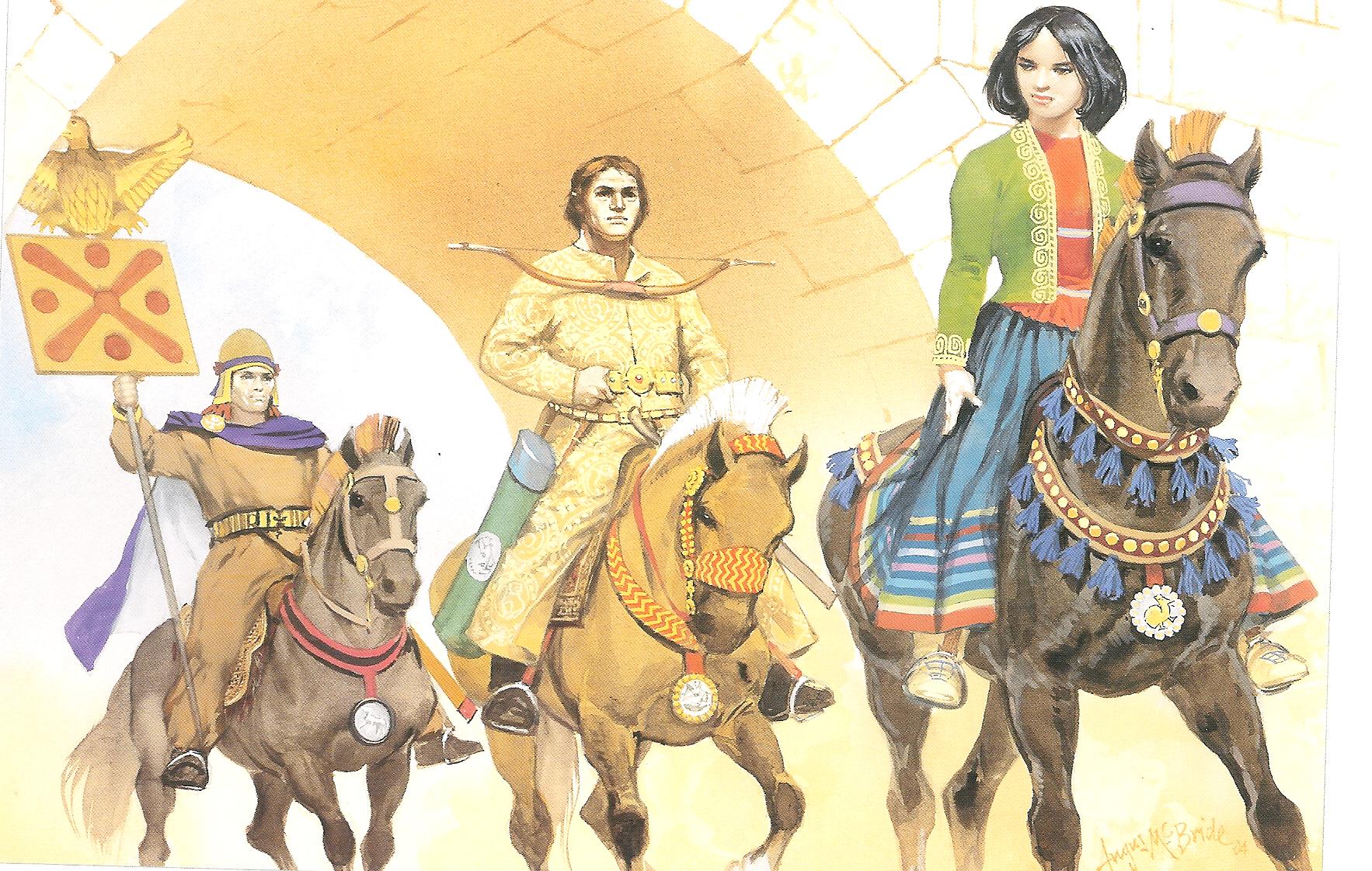 [CLICK TO ENLARGE]- A reconstruction of the late Sassanians at Shiz (Takht e Suleiman in Azarbaijan, northwest Iran). To the left rides a chief Mobed (a top-ranking Zoroastrian priest or Magus), General Shahrbaraz (lit. “Boar of the realm”) is situated in the center and Queen Boran (Poorandokht) leads to the right. General Shahrbaraz defeated Byzantine armies to conquer Byzantine-ruled areas in Syria, the Levant, Egypt with Constantiinople being placed under siege. Picture source: Farrokh, Plate G, -اسواران ساسانی- Elite Sassanian cavalry, 2005.
[CLICK TO ENLARGE]- A reconstruction of the late Sassanians at Shiz (Takht e Suleiman in Azarbaijan, northwest Iran). To the left rides a chief Mobed (a top-ranking Zoroastrian priest or Magus), General Shahrbaraz (lit. “Boar of the realm”) is situated in the center and Queen Boran (Poorandokht) leads to the right. General Shahrbaraz defeated Byzantine armies to conquer Byzantine-ruled areas in Syria, the Levant, Egypt with Constantiinople being placed under siege. Picture source: Farrokh, Plate G, -اسواران ساسانی- Elite Sassanian cavalry, 2005. 